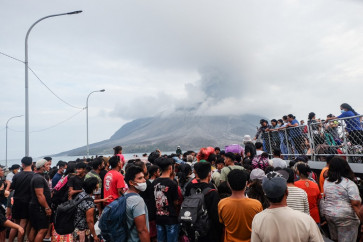Exporters split over outlook as govt eyes nearly $200b
Indonesian exporters are gearing up to boost overseas sales as the government has set an ambitious export-growth target at a time when the global economic outlook remains bleak
Change Size

Indonesian exporters are gearing up to boost overseas sales as the government has set an ambitious export-growth target at a time when the global economic outlook remains bleak.
While industries such as automotive, motorcycle and footwear ' which export to emerging economies ' are optimistic about exports this year, others, such as palm oil and textile exporters, are facing difficulties from the weak global economic outlook, according to industry players.
The government has set a 25.67 percent growth target to US$192.9 billion for non-oil and gas exports this year from $153.5 billion estimated last year.
Indonesia's major trading partners, from China, Japan to European countries are struggling to boost growth, possibly affecting demand from the world's largest economies. Meanwhile, softening prices will possibly weigh on the country's commodity reliant exports in line with the slump in global oil prices.
Indonesian Palm Oil Producers Association (Gapki) said overseas demand for palm oil would only rise moderately, particularly in main buyers China, India and the European Union. Such a situation forced the group to set a moderate export growth target of 2 to 3 percent from 21 million tons estimated for 2014.
'This is another difficult year. We will not see much growth as the demand is still weak,' said Gapki executive director Fadhil Hasan, adding that eroding competitiveness as a result of a smaller gap in prices of palm oil and other edible oils would also cloud the prospects.
Earnings from palm-oil exports, the second-biggest contributor to non-oil and gas exports in Southeast Asia's biggest economy, surged by 10.25 percent to $17.56 billion from January to November last year, according to the latest data from the Central Statistics Agency (BPS).
To help meet the goal, palm-oil exporters will also extend its reach in new markets, such as Turkey, Bangladesh and Eastern Europe, Fadhil said.
Economists have warned that China might only expand by only 7.3 percent in 2014, less than the 7.5 percent expected, in what may be a failure in the world's second-biggest economy to meet its target for the first time since 1998.
Further deterioration also haunts Japan, which in the second quarter of last year fell into a recession, driven by weaker private consumption. Meanwhile, the eurozone may experience downturn this year, as growth in the final quarter of last year may remain stagnant.
Indonesian Textile Association (API) chairman Ade Sudrajat shared that the continuing slump in global demand was coupled with the shrinking competitive edge of domestic textile products caused primarily by higher electricity and labor costs. In general, prices of textile from Indonesia are 10 to 20 percent higher than its Asian peers, such as Vietnam and Bangladesh.
'We don't have a target. Exports this year may only remain at $12.6 billion [which is similar to] last year,' he said. From January to October last year, overseas textile sales rose slightly by 0.3 percent to $10.74 billion, or still $2 billion short of the target.
Some business groups expressed their optimism in spite of the bad external outlook. Footwear, cars and motorcycle manufacturers expect their overseas shipments to jump at a double-digit rate, buoyed by stronger demand in some markets as well as an enhanced competitive edge in domestic .
Automakers expect exports to surge markedly by between 25 percent and 50 percent to between 250,000 and 300,000 units this year, said Jongkie Sugiarto, the Indonesian Automotive Manufacturers (Gaikindo) vice chairman.
From January to November exports of four-wheelers in the form of completely-built units (CBUs) reached 185,229 units, inching near the 200,000 units sold as estimated in 2014, according to statistics from the business group.
'Demand from our export destinations is quite good and our domestic production capacity is sufficient to meet the rising number of orders,' Jongkie said.
Motorcycle manufacturers shared the optimism of car makers, saying that exports of two-wheelers might climb by nearly 20 percent to 50,000 units. Throughout last year, local motorcycle firms sold 41,746 units, up 53.85 percent from 2013, according to the Indonesian Motorcycle Association (AISI).
Milder growth would be affected by some factors that may increase production costs, including the depreciation of the rupiah against the US dollar and higher labor wages.
'Apart from that, as our destinations are mainly developing countries, economic slowdown will disrupt demand and it will be hard for us to encourage exports,' said AISI chairman Gunadi Sindhuwinata.
At present, outbound motorbike shipments head mostly to Asian countries such as Vietnam, Pakistan and Bangladesh, while the minority goes to Middle East nations, such as Iran, and South American countries.
However, Gunadi added that with motorbike riding becoming a popular trend in several developed countries, new opportunities might be on the horizon. Indonesian Footwear Association (Aprisindo) secretary-general Binsar Marpaung said that his group was eyeing exports to hit $5 billion this year, up 31.58 percent from last year's $3.8 billion. Despite improved demand from some markets, such as the US, brighter prospects were attributed to labor-cost solutions.
Favorable labor wages will enhance the competitiveness of Indonesia's footwear overseas, according to Binsar. The government has stipulated that the annual labor-wage increase in the labor-intensive industry, including footwear, is subject to special arrangement due to its dominant share in overall production costs.
- Automotive, motorcycle, footwear are the optimists
- Palm oil, textile see difficulties in boosting growth
- Govt wants to see exports grow 25% to $192.9b









